
Ding! Ding!
A dummy notification drags you out of the meeting.
Dismiss.
You look back at your computer screen.
But a tiny distraction was enough to lose track of the conversation.
Could you repeat the question?

Hi, there! Today I want to share a few things that went live recently.
On the podcast.
I released a new episode with Aziz Barbar on non-fungible tokens (NFTs), blockchain, cryptocurrencies, and digital art. You can listen here.
I know very little about the fast-moving world of digital currencies and the new age of digital art, and these byte-sized episodes are an attempt for us to catch up with the latest developments. I intend to publish essays on the topic to share my findings.
While everyone's wondering whether the representation of ownership of digital creations with tokens is a bubble, events such as the 69-million dollar sale of Mike Winkelmann's body of work—@beeple_crap—in an auction by Christie's significantly contribute to the validation of this piece of technology.
A future episode with Aziz will discuss the role of black-box algorithms in our culture.
On the live stream.
Last week, I hosted two live events on YouTube to record a two-part podcast celebrating One Year of Live Streams, to be released soon. The first part features audience questions regarding the evolution of the live stream after a year of weekly streams. The second is a follow-up conversation with Jose Luis Garcia del Castillo on our experience coding live.
Elsewhere.
Lastly, Jose Luis invited Andrew Heumann to his Introduction to Computational Design class (GSD-6638) at the Harvard GSD to give a guest lecture on Architectural Automation & Augmentation. You can watch here.

Paradoxically, announcing there's no post today means there's a post.
My commitment is to publish a sketch and story every Tuesday, both in English and Spanish. And it isn't easy. I find joy when I schedule my weekly publications in advance, and I often fantasize that I'll put the hours needed to prepare posts weeks, maybe months, ahead of time. But that rarely happens. I was close to doing that for August, looking to unplug from the screen during my vacation. Yet, I ended having to do some writing, translating, and Photoshoping amongst the hot days of Summer.
Here's a personal note I wrote on the morning of July 7, 2021.
Writing a good newsletter post with 466 words […] makes me feel good. It's Monday morning, and my post (in English and Spanish) is scheduled for tomorrow. It's 9:40 AM, and I need to keep going, making progress in other areas not to be caught empty-handed later on my day.
I realize how great it feels to finish to-dos early in the day, going on with your day without pressure. It's then when I think, I wish I did this more often! But, no matter how much structure I try to introduce into my daily routine, every day is different.
As you can see, I lied—I had the first line of this essay as a backup post in case I had to miss a publication, but it ended up sparking a reflection that I decided to share with you today.

Back in August 2018, Panagiotis Michalatos and I sat down at the back porch of his house in Cambridge, Massachusetts, to chat for a couple of hours. Pan, as people often call him, is one of the most intelligent persons I've ever met, and I was lucky enough to have him share his idiosyncratic worldview over a microphone with me.1
The way he lives and works, the clothes he wears, and the way he designs or codes, inspired me to think of one word: minimalism.
Minimalism is the reduction of anything to its essential elements, stripping out the superfluous and bringing to light nuances that might otherwise ego unnoticed. The result of that reduction is what we often call simple.
Paradoxically, simplifying any process, artifact, or concept, is complex. Minimalism and simplicity are hard. Our nomad predecessors would clutter a space and, after its use, would move somewhere else, start from scratch, and let nature clean up the mess. But we're stuck in one place.
In our times, minimalism often implies getting rid of possessions and keeping only the things we use and value. Certainly, not something everyone can afford.
As Pan told me on his podcast episode, when you have too little, you want to hold on to anything that comes your way, because you can loose it immediately. "You need to have the luxury to choose to simplify your life."
If you listen to Pan's episode, pay attention to the background sounds. You'll not only hear birds chirping and insect sounds coming and going as the night falls but golf irons hitting the ball, tree leaves shook by the wind, and buses passing. ↩
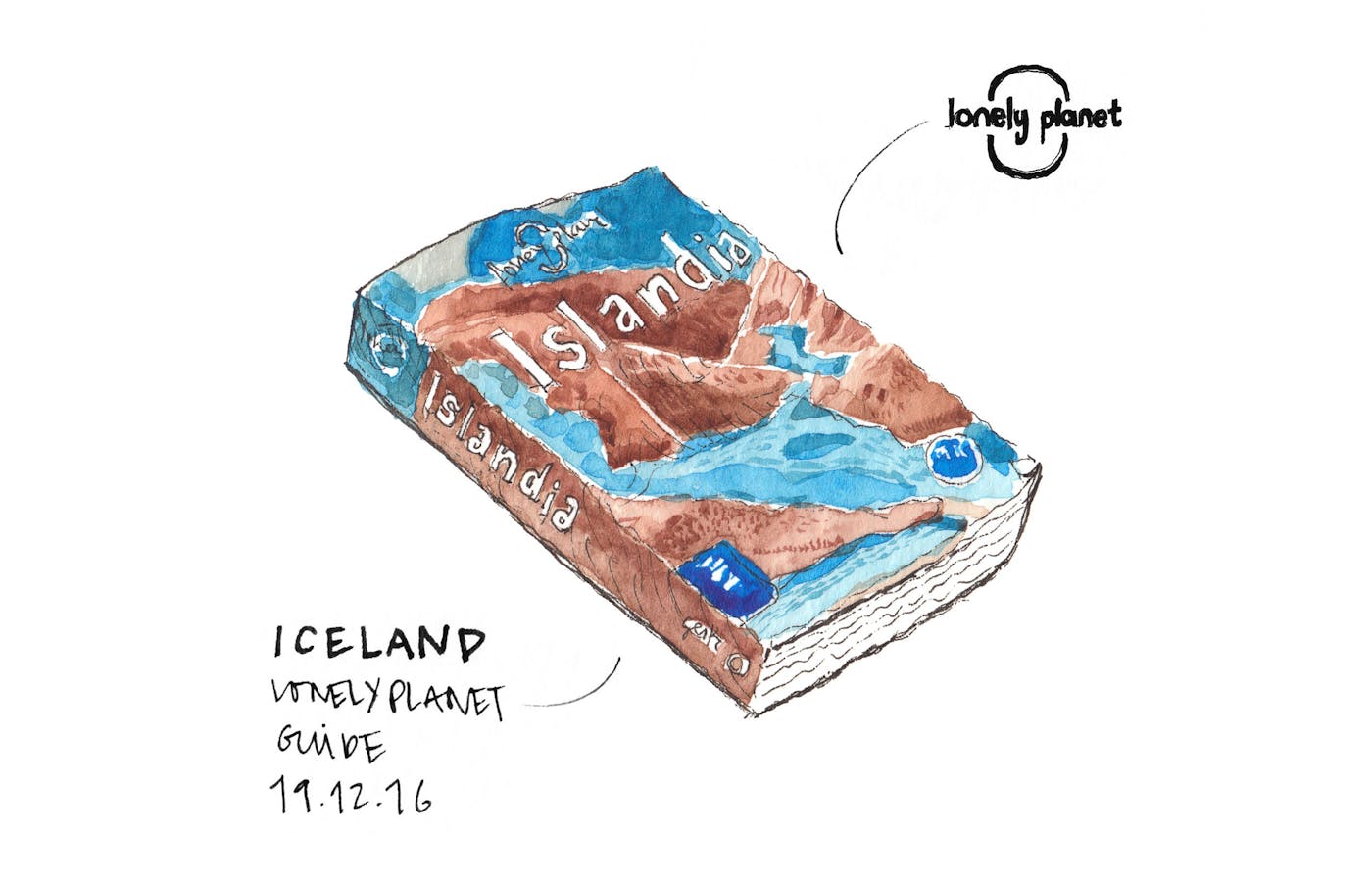
There's a subtle difference between the manual and the guide.
The manual is meant to tell you how to use and assemble your new gadget—the very function of every single button; the place where every nut and bolt need to go.
A hand-recorder, for instance, ships with a printed booklet—a manual—that contains detailed instructions on how to use it; LEGO blocks and IKEA furniture ship with meticulous step-by-step instructions on how each of the pieces fit together. Without these detailed instructions, we would probably end up with ingenious, original combinations of the parts, but we might not get to build the shelf or toy we bought at the store.
Unless you're really familiar with hand recorders, it's unlikely you'll discover all of the capabilities your recorder is armed with without studying its manual.
The guide, however, offers advice and guidance along a given process but doesn't provide detailed instructions. No enumerated steps to follow but recommendations and tips and insights to learn from.
Guidebooks guide the tourist around a foreign country, introduce the newbie to a new activity, and educate the amateur with esoteric knowledge.
It's great to follow the manual when the equation requires precision and accuracy. (You don't want your shelf to fall apart!)
In your day to day, though, there's no need to be constrained by exact steps.
Are you following the steps in the manual or using the tips in the guide?
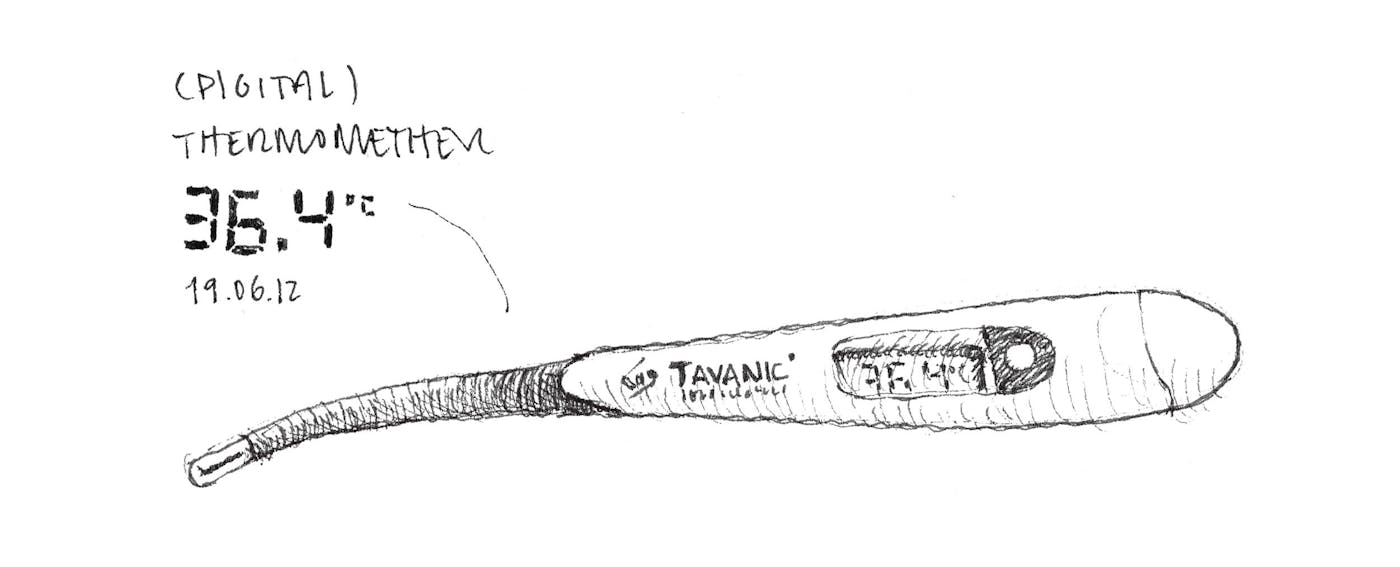
Yesterday, my body temperature got up to 39.7 Celsius degrees. I was shivering with fever and felt like crap.
We have all these plans we want to do, places we want to visit, and projects we want to work on. From Monday to Friday, work is imperative. Yet, a simple fever prevents you from going to work. The slightest sickness can render essential things expendable.
I've spent many hours in bed over in the last two days, and finding the time to write this was challenging. But these are the days that make me appreciate the times in which I feel good even more, when I'm free to choose what to do instead of laying down in bed.

If I were to ask you where your keys are, would you know? What about your passport? And what about what's in your pockets right now?
"A place for everything and everything in its place," says the old proverb.1 Designating a place for each of your belongings and returning them to their assigned location after each use makes it easier to find anything in the future, but keeping everything organized isn't easy. As a first step, we can focus on designating a location for each of our frequently-used items.
Carrying your phone in your pocket creates a shortcut. It's easier to take it out your pocket than it is to take it out of your backpack or purse. Each pickup will be easier and you'll use it more often.
I reserve the small pocket of my jeans for my home keys (the pocket originally meant for men to keep their pocket watches); the left pocket for my phone; and the right pocket for my wallet and AirPods. It's automatic and I know where to find them.
Placing the things you use the most within easy reach will make using them more comfortable. You can even make copies of some of these items to access them from multiple places. You won't buy two phones, but it's easy to make copies of your keys, for instance.
That's why the digital shortcut is awesome; you can create copies of your files for free, spread your most valued content across devices and folders and the cloud, and share a copy with your friends and co-workers.
What's in your pocket?
Learn more about the origins and meaning of this phrase. ↩

I like to re-visit how nervous or stressed or calm or impatient or curious or mistaken I was before a given event was about to happen. Maybe, I was nervous about meeting someone for the first time or interviewing a podcast guest. Maybe, I felt the struggle of doing something hard when I wasn't used to it, something that today come naturally to me today. Maybe, I was holding thoughts or opinions that turned out to be completely wrong afterwards.
Our mind is skilled at altering memories and experiences from the past. I find it rewarding to mull over journaling notes, from weeks, months, or even years ago, to encounter thoughts I couldn't recall anymore, simply because I managed to capture them on time.
I love Laura Vanderkam's suggestion to be grateful every week at least for a few minutes. "Things that were once uncertain seem, in retrospect, to be inevitable. You can choose, however, to rekindle some of the joy you felt after winning that promotion or landing that record deal. Simply remind yourself of where you once were, and where you are now, and the gulf between them that’s as wide as the ocean blue."1
168 Hours: You Have More Time Than You Think. Laura Vanderkam. Penguin. 2011. ↩

You are, once again, in that long line at the airport to get your boarding passes and drop your bag. Your luggage includes three items—a check-in suitcase, a carry-on, and a small backpack, maybe a purse—and now you're next in line. (To be honest, a little nervous.) Your bag is over the 23 kg limit, and it's your turn. Passport in hand, you go to the counter and are prompted to place your suitcase on the weight. The machine reads 24.5 kilos. Overweight! You think to yourself. It's all fine—the lady smiles—wrapping a tag around your suitcase's handle and sending it in through the conveyor belt. Here are your boarding passes. Have a safe flight!
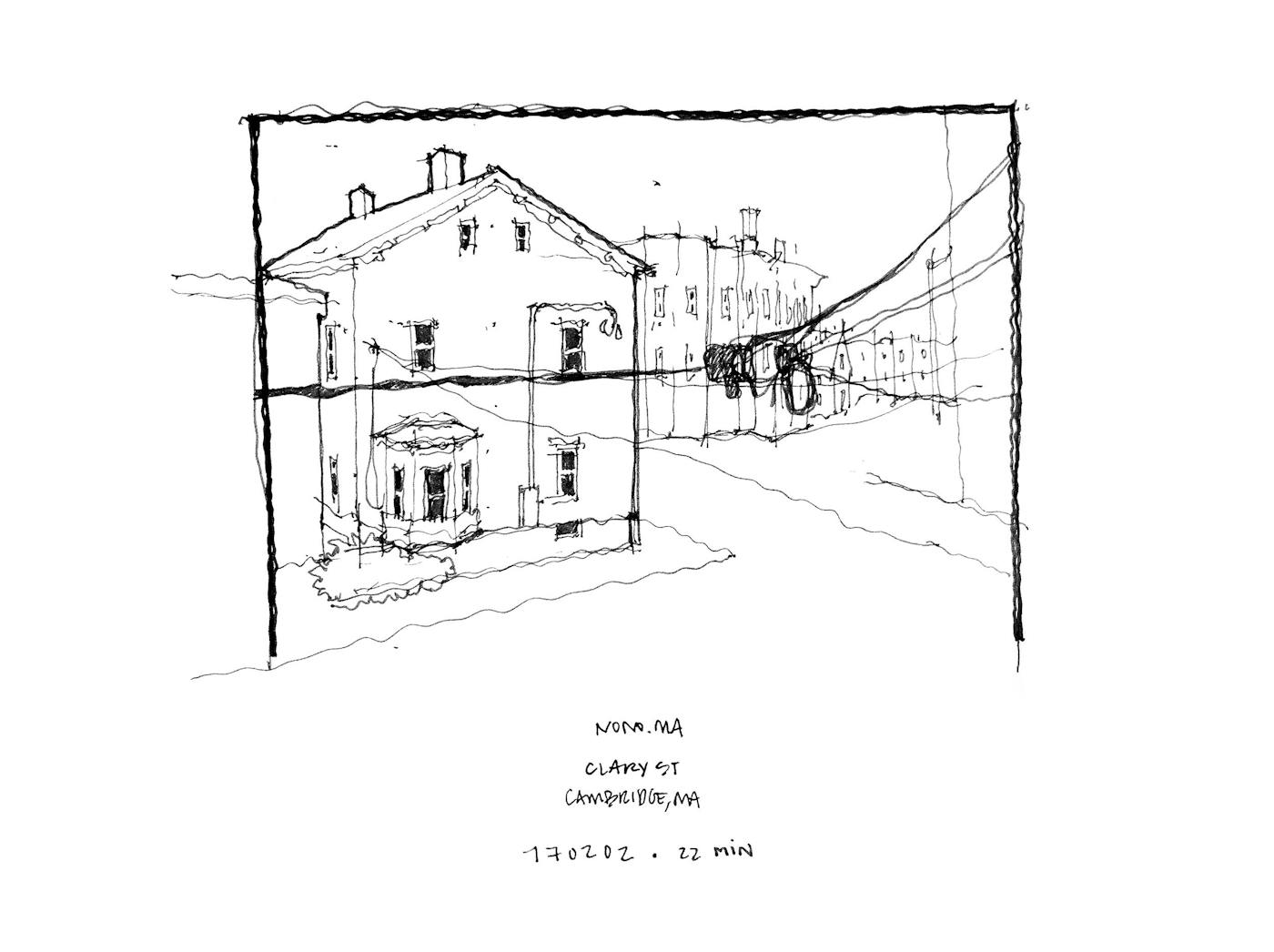
It snowed two days ago, the snow melted yesterday, and Cambridge is sunny today. With clear skies, temperatures go low.
I had been learning Go programming all day and needed a break. My first thought was to go for a walk or sketch outside, but I didn't really felt like going outside in such cold weather, so I decided to draw the same house my mom had sketched six months before from my window. I didn't notice the amount of cables until I sketched them.
I wrote those words the morning of February 2, 2017, right before sketching this view from my desk. A year and a half before, in August 2015, I would arrive to our shared student apartment in 8 Clary St, Cambridge, Massachusetts.
My room was a spacious studio originally meant to be our living room, one of the most special places I've lived in that became my home for the three winters to come. I probably spent thousands of hours meditating and starring out of my bow window, talking on the phone and working at my desk—a two-and-a-half-meter-long kitchen top from IKEA, finished in beech, sitting over two black table legs.
Looking out the window, I've seen my girlfriend, family, and friends—including roommates and podcast guests—get home; my bike locked to street signs; random passersby walking along Prospect St; and the white snow cover the streets in winter.
I captured my room and a few other spaces in Cambridge the months preceding my departure in the form of 360-degree virtual reality panoramas that I revisit from time to time using a simple Google cardboard set. I keep surprising myself with the power of these virtual reality scenes—which include sound and imagery—to bring me back to Cambridge. If only for a second, I'm fooled into thinking I'm still there; biking from Clary street to Harvard and then to MIT, commuting to Boston Seaport, or simply hanging out with friends for dinner. Sweet memories.
I'm not sure how many times I looked out that window, but looking at these sketches sparks joy.
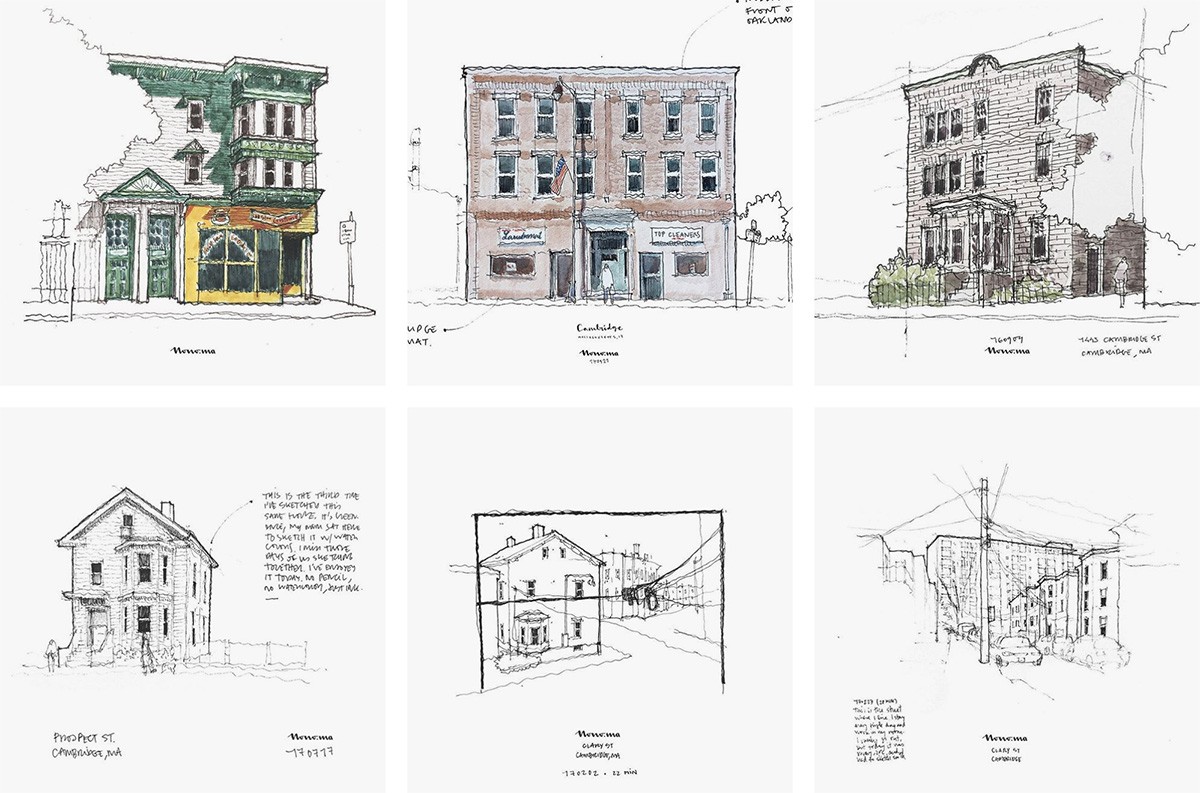
I've been drawing since I was young. Ever since I remember, I enjoyed spending hours putting things on paper, but it wasn't until architecture school that I started sketching spaces on site. For some architecture classes, we would be given an assignment: Go to specific areas of the city to sketch certain buildings and public spaces and bridges, and—most importantly—draw them on location. The point wasn't to go to the site and take pictures and then draw at home but sketching right there. For me and some of my friends, it was a fun weekend activity to start Saturday walking around the streets from early morning.
Today, I still enjoy wondering around with my sketchbook—at times with my mom, and some other times with friends. Thanks to UrbanSketchers, I continued drawing while I was in Spain, Sydney, or London, and continue to do today, here in Cambridge, Massachusetts.
What I want to share with you today is a recently-started project: sketch.nono.ma. A project to document and share my sketches online, and to produce high-quality prints out of the ones I like the most. You can take a look on Instagram and on the sketch.nono.ma website.
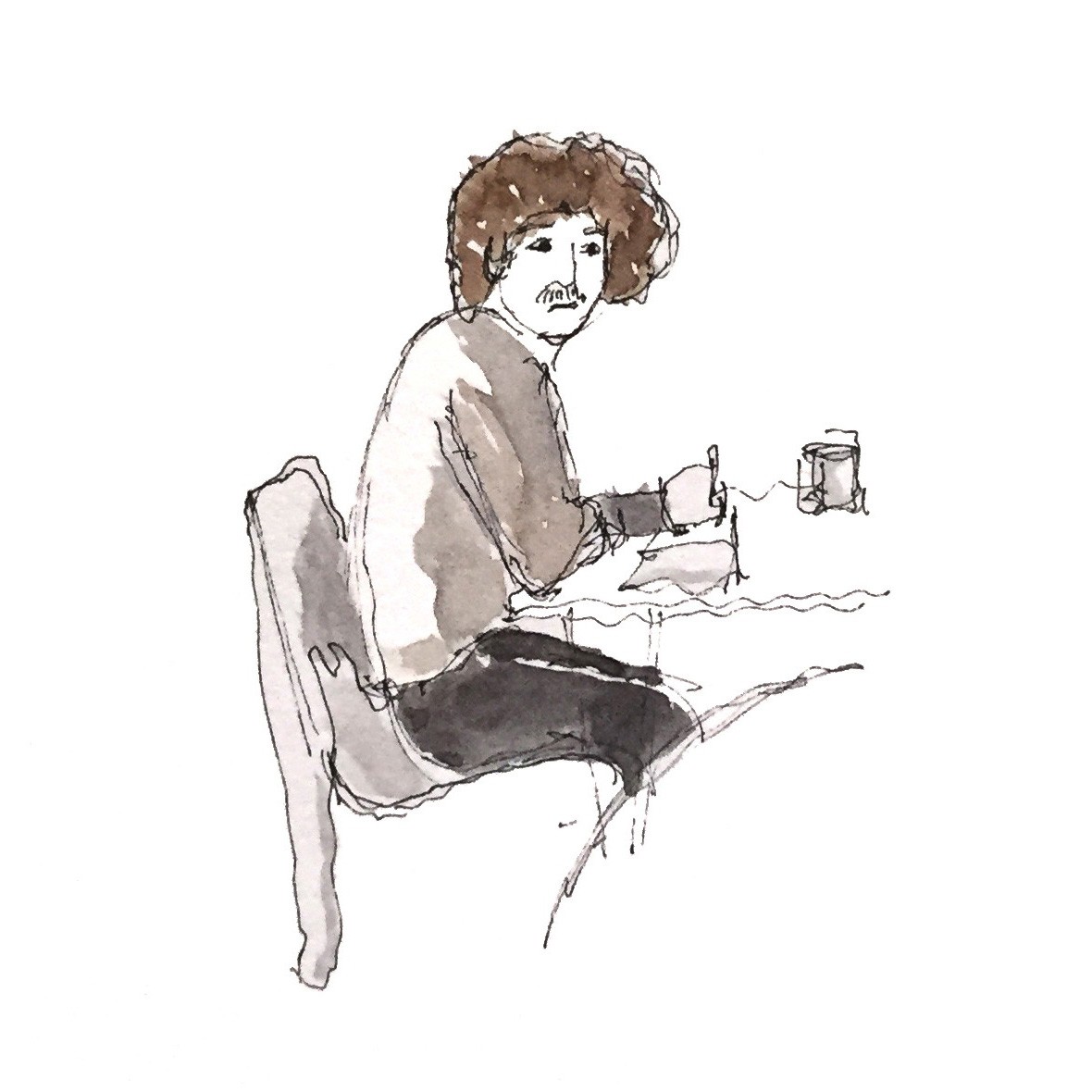
Write for yourself. Talk about the things you care about. Construct an opinion on them. Take a clear position. Then, be flexible — as you learn more, your position might change.
This is what I tell myself when I sit to write. I learn (a lot) by reading what others say — but we won't go too far if we don't build an opinion of our own.
As Seth Godin would say: Don't hide. Write in public.
Then maybe, just maybe, what you write will resonate with your audience.

In the event of a disaster, we would probably leave most of our belongings behind. You're not likely — I hope — to care so much about your fancy tea mug, your watercolors, or whatever piece of clothing you own, as to put your life in danger to save them. Today, with the exception of digital information not backed to the cloud and other unique hand-crafted objects, everything we own can be replaced for an item which is exactly the same. After a disaster, great part of our stuff might be gone. If you manage to get out of there with no important injuries, you have, without choosing it, adopted an unsolicited minimalism — you've got rid of stuff without looking for it.
No disaster? You might never get around getting rid of stuff. Belongings accumulate and, the more storage space you own, the more you'll accumulate. The thing is: we usually don't care much about most things we own. We tend to only love a small portion of it.
Marie Kondo, author of The Life-Changing Magic of Tidying Up: The Japanese Art of Decluttering and Organizing, was interviewed by Tim Ferriss not long ago. She is known as the Japanese tidying master, who created the KonMarie method. Her motto? "Love everything you own." She believes we need to be thankful of our belongings, thank them for their service while we have them, and, more importantly, before we get rid of them. This way, on top of appreciating the item itself, we remove the feeling of regret for getting rid of it (a feeling that frequently prevents people from letting go of things they don't need any more).
This, I believe, goes inline with what William Morris said in his 1880 lecture titled The Beauty of Life1. "If you want a golden rule that will fit everybody, this is it: Have nothing in your houses that you do not know to be useful or believe to be beautiful."
As a friend pointed out, in Spain we often say that "moving three times equals a fire2." Will you wait for a disaster to take action? Or will you fake your own so you can get rid of the useless and love what you own?
William Morris was an influential designer, writer, and socialist of the nineteen century. ↩
"Tres mudanzas equivalen a un incendio." ↩